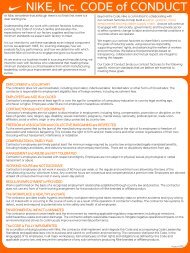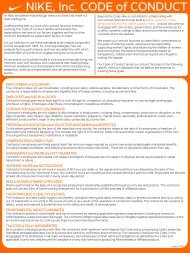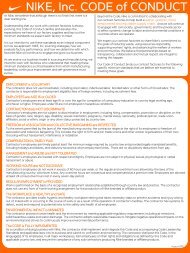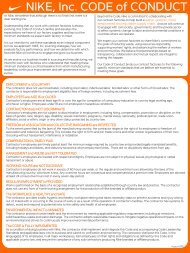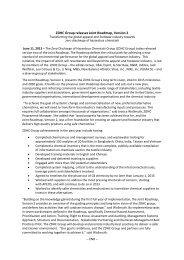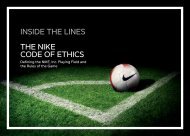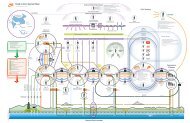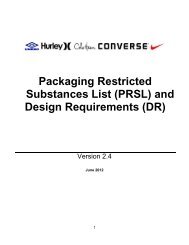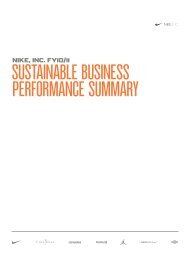COC CLS - Healthy Safety Environment - NIKE, Inc. - The Journey
COC CLS - Healthy Safety Environment - NIKE, Inc. - The Journey
COC CLS - Healthy Safety Environment - NIKE, Inc. - The Journey
You also want an ePaper? Increase the reach of your titles
YUMPU automatically turns print PDFs into web optimized ePapers that Google loves.
OCCUPATIONAL EXPOSURE LIMITS<br />
STANDARD<br />
<strong>The</strong> contractor provides a safe, hygienic and healthy workplace setting and takes necessary steps to<br />
prevent accidents and injury arising out of, linked with or occurring in the course of work or as result of<br />
the operation of contractor’s facilities. <strong>The</strong> contractor has systems to detect, avoid and respond to<br />
potential risks to the safety and health of all employees.<br />
‣ Develop and implement processes and procedures to reduce or minimize the risk associated<br />
with worker physical, biological and chemical exposures. Maintain exposures at levels<br />
protective of worker health. At a minimum, reduce exposures to below established<br />
occupational exposure limits (OEL) where available, or as defined by local and international<br />
thresholds. Contractor must comply with requirements as outlines in this standard or relevant<br />
local laws and regulations, whichever is more stringent.<br />
‣ Comply with the abrasive blasting addendum.<br />
RESPONSIBILITIES<br />
Location Manager must ensure that procedures for occupational exposure limits are developed,<br />
implemented and followed.<br />
HSE Representative must establish, maintain and administer the processes and procedures for this<br />
standard.<br />
Managers and Supervisors must ensure that employees receive training and comply with the<br />
requirements of the processes and procedures for this standard.<br />
Employees must adhere to the requirements of the processes and procedures of the occupational<br />
exposure limits standard.<br />
DEFINITIONS<br />
• Indoor Air Quality is the condition of the air inside buildings, including the extent of pollution caused<br />
by smoke, dust, fumes, mist, biological hazards and gases and chemicals from materials, processes<br />
and appliances.<br />
• Biological Hazard is an airborne organic contaminant that is either generated by, or is itself, a living<br />
organism (also known as a bio-aerosol). Common bio-aerosols include bacteria, fungi, molds,<br />
mildews, dust mites, spores, legionella and pollen.<br />
• Chemical Hazard is an element or mixture of elements or synthetic substances that are considered<br />
harmful to employees.<br />
• Physical Hazards are unsafe conditions that can cause injury, illness and death (e.g. unguarded<br />
machinery, working at height, electrical hazards, heat, noise, slip and trip hazards).<br />
REQUIREMENTS<br />
1. RISK ASSESSMENT—Each facility must have a documented annual risk assessment conducted for<br />
each process and/or work area, which includes as a minimum:<br />
a. Identification of hazards associated with the process and/or work area (including chemical,<br />
physical and biological hazards).<br />
<strong>Safety</strong> <strong>CLS</strong> – Page 1 Revised 01.01.12



